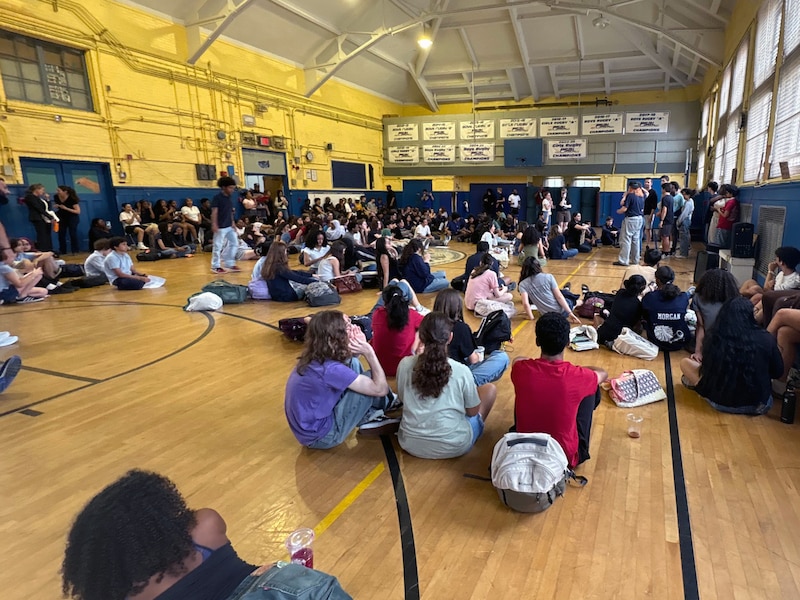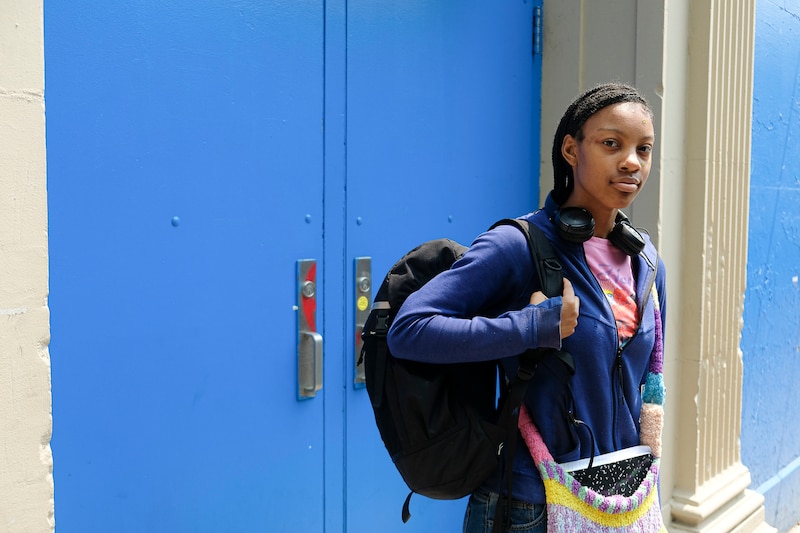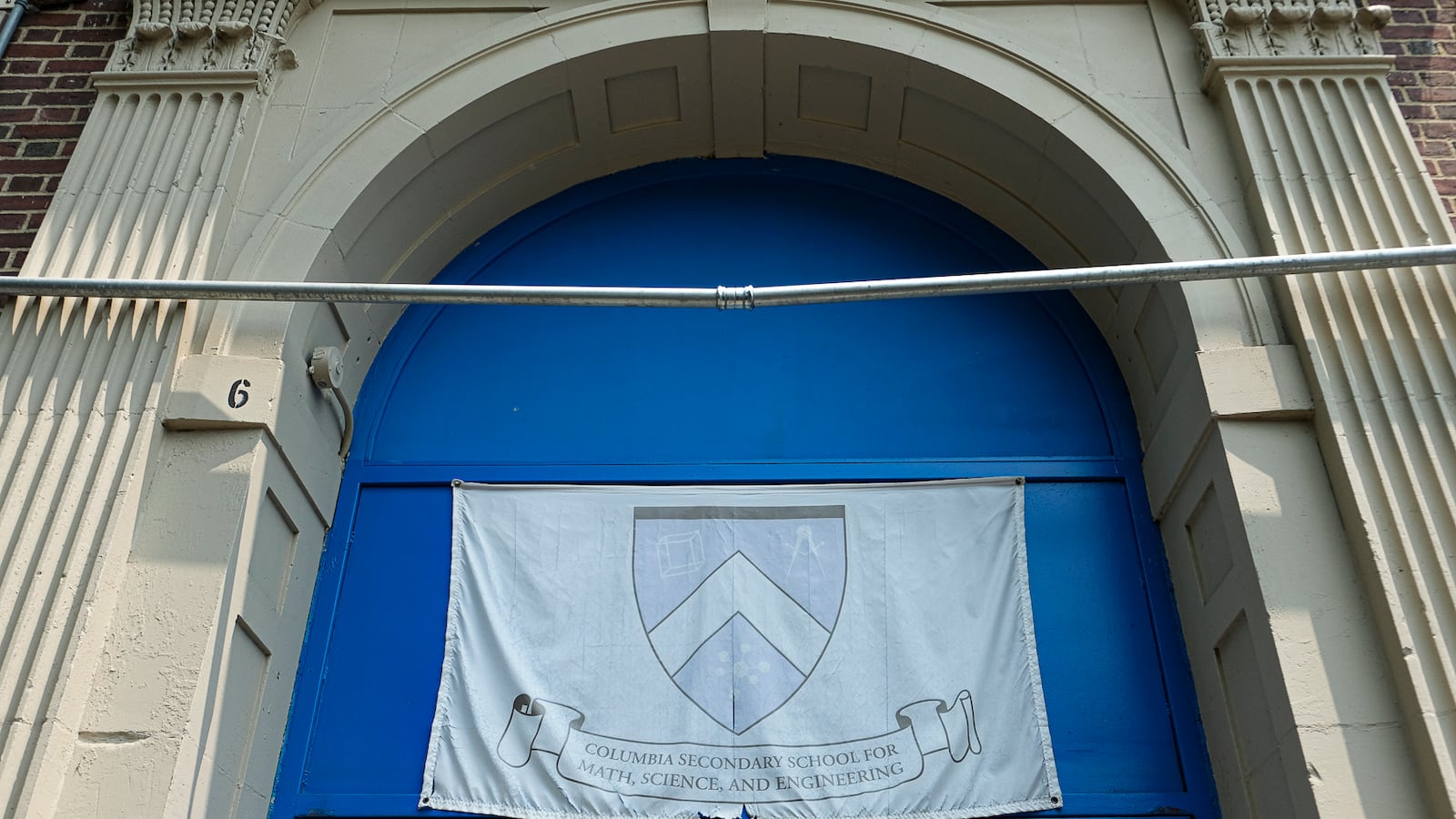Sign up for Chalkbeat New York’s free daily newsletter to get essential news about NYC’s public schools delivered to your inbox.
Two weeks before the end of the school year, Columbia Secondary School students packed into their Harlem gymnasium to air their grievances, carrying cardboard signs that read, “Teachers are resigning. Our community is broken,” and “This shouldn’t be our problem.”
The sit-in came one day after students learned that John Beletsky, a beloved ninth grade English and philosophy teacher, would not be returning in the fall.
Beletsky, a nine-year veteran of the school who also led the student band and Model United Nations, was the latest in an exodus of educators at the high-performing 6–12 public school since Principal Vikram Arora took over in March 2023.
The past two years have seen major shifts in the curriculum and culture at the 18-year-old school, which has strong ties to Columbia University. Six current and former staff members and eight students told Chalkbeat that a top-down approach to decision-making, lack of transparency, and concerns about whether students with disabilities are receiving adequate services and support have caused growing discontent. Those issues recently erupted into student-led protests.
By the end of the 2023-24 school year — the first full one with Arora at the helm — 13 employees, or nearly 22% of the staff left, according to Education Department data compiled by the Independent Budget Office for Chalkbeat. That was more than double the citywide staff turnover rate. The school had already lost some staff members after the retirement of longtime Principal Miriam Nightengale at the end of the 2021-22 school year, with 14 total departures that year. The year before, the school lost just two educators, or nearly 4% of the staff. (Data for the most recent year is not yet available.)
“ Students themselves have felt the pain of that,” said rising junior Gwen Zangre.
As the 720-seat school loses teachers, some students have lost access to some of the classes that drew them to Columbia Secondary in the first place. In late May, a student created a widely circulated petition demanding leadership changes. Earlier in June, students planned a walkout, but school security guards blocked them from leaving the building.

At the June 13 sit-in, multiple students confronted Arora and Assistant Principal Zach Lynn about Beletsky’s departure and what they described as a broader pattern of staff resignations, according to videos obtained by Chalkbeat.
An 11th grader detailed how abrupt changes to the curriculum of her 10th grade global history class had created undue pressure in the classroom.
“Teachers don’t feel listened to, which is why they’re leaving,” she said into the mic, “and students don’t know what’s going on because the leadership doesn’t communicate.”
Another student added, “The teachers who are still here are completely overworked.”
Arora told the hundreds of students gathered in the gymnasium that he and Lynn were taking “this feedback very seriously.”
“I concede to the fact that some teachers may not like what has happened and they might leave,” he said.
In a subsequent letter to families about the sit-in and Beletsky’s resignation, Arora acknowledged that it was “an emotional day” for many students.
“As we look ahead to the new school year, we are committed to creating more frequent, substantive, and consequential opportunities for students to be heard and to help shape the academic, athletic, and cultural life of our school,” he wrote.
Arora and Lynn referred Chalkbeat’s questions to the Department of Education’s press office, which said that a team from the District 5 superintendent’s office in Harlem is conducting more classroom visits and has held meetings with student leaders, the PTA, and the School Leadership Team to hear concerns, monitor progress, and reiterate expectations.
“In partnership with the school community, our central offices are implementing next-step interventions to ensure all students and staff are set up for success,” Chyann Tull, a Department of Education spokesperson, wrote in a statement. “Columbia Secondary School continues to outperform citywide averages, with strong student outcomes and a rigorous, college-preparatory curriculum.”
Columbia Secondary’s evolution in upper Manhattan
Columbia Secondary School for Math, Science & Engineering first opened its doors in 2007 with support and funding from Columbia University. Located north of Morningside Park, the school was conceived of as a way for Columbia — which had drawn scrutiny for its rapid expansion into historically Black Harlem by seizing homes and businesses through eminent domain — to give back to the neighborhood.
Under the agreement, Columbia faculty would help to create a customized curriculum for the school, and students could take courses and explore internship opportunities at the Ivy League institution. As part of its mandate, the school also had to reserve at least half of its seats for students from the surrounding neighborhoods of East, West, and Central Harlem, the Upper West Side, Inwood, and Washington Heights.
Today, more than half of the school’s students are Black or Hispanic, and just under a third are white. About half of Columbia Secondary’s student body is economically disadvantaged, and 1 in 5 students are now classified with a disability. The school currently reserves all of its seats for students from the neighboring areas. It operates out of a co-located building on West 123rd Street, which it shares with KIPP STAR middle school and P.S. 125 The Ralph Bunche School.
From the start, Columbia Secondary built a reputation for its rigorous liberal arts curriculum and high student achievement. All students were required to take political philosophy during their junior year and physics in 10th grade, for example. Rather than preparing for the global history Regents exam during their sophomore year, students undertook a major research paper intended to help them build college-level writing and critical thinking skills.
Signs that trouble was brewing at the school began to emerge in last year’s New York City Schools Survey results. Of more than 2,600 schools that participated in the survey citywide on teacher-principal trust, the school ranked in the bottom 10. Only 24% of staff responded favorably — a steep decline from previous years, according to a Chalkbeat analysis. (The survey results include charter schools and early childhood centers.)
Just 18% of the school’s teachers agreed with the statements, “I trust the principal/school leader at their word (to do what they say they will do),” and “The principal/school leader places the needs of children ahead of personal interests.”
Nine percent said they agreed or strongly agreed that the principal and assistant principals at the school “function as a cohesive unit,” placing Columbia Secondary among the bottom five schools citywide on that question.
One example, shared by Beletsky and others, of a change that affected trust in the school’s leadership involved the 10th grade global history teacher. The teacher was notified at the start of the school year that she would have to scrap her course’s research paper component and replace it with Regents exam prep.
The change sparked swift backlash from students and parents, and several months into the school year, the administration agreed to reinstate the paper. By the end of the year, school leaders and the teacher reached a compromise: Students could choose either to write the paper or take the Regents exam — but the teacher had to teach for both in the same class.
In other examples from students and teachers, the once-mandatory courses in 10th grade physics and 11th grade political philosophy became optional, and the school now only offers AP Spanish virtually. That decision was made without real input from Spanish language teachers, according to another teacher familiar with the changes.
Some teachers have left as a direct result of changes implemented by the new administration.
Last year, special education teacher Leslie Seifert, who also taught the school’s journalism elective, sent an email to his colleagues informing them that he had resigned from Columbia Secondary.
“The event that pushed me over the brink was when the principal eliminated my journalism course without discussing this decision with me, or even informing me of it,” Seifert wrote, adding that he first learned of the course cancellation when it didn’t appear on that year’s list of elective course offerings.
In a recent interview with Chalkbeat, Seifert said he remained unsettled by the administration’s apparent reluctance to engage with staff or to understand the school’s culture.
“It’s not just a lack of communication. It’s a lack of interest and curiosity,” he said.
Staff shortages, special education complaints
Despite the school’s high academic performance, staff and students said they were concerned about the administration’s push toward more Advanced Placement courses without enough teachers to teach the classes.
Beletsky confirmed that he and others taught six periods a day, rather than the contractual norm of five classes, in order to offset staff shortages at the school. Teachers who agree to extra periods of instruction are compensated for it, per contract rules — but several staff members said the additional workload can lead to teacher burnout, take away from other responsibilities, and lower the quality of instruction.
Students told Chalkbeat that the push for more course options, coupled with staff shortages, has impacted the teachers’ ability to give individualized attention and in-depth feedback.
“The quality of classes is really going down, especially in terms of being able to get feedback on your work,” said Susan Leites, a 2025 graduate.
“When we ask them why after they leave, they say ‘It’s not because of you guys, it’s because of the administration. It’s because they overwork us’,” said another recent graduate, Enzo Martinez-Klobnoch, who launched the online petition.
Some students with disabilities, who are entitled to have their classes co-taught by a general education teacher and a special education teacher, have also had to drop that support in order to take AP courses, according to former and current teachers.
In response to the online petition, Arora described allegations that students with disabilities “are being pressured to forgo support services” as “categorically false.”
“Our current special education compliance rate is near 100 percent,” he wrote in a May 26 email obtained by Chalkbeat.
But Beletsky argued that administrators at Columbia Secondary have asked students with disabilities to waive certain services so that the school’s inability to provide that service wouldn’t count against its compliance record.
“They’ve just gotten very strategic about making sure that people opt out,” Beletsky said.
While students with disabilities, who are entitled to having a co-teacher, can amend their special education program to enroll in a course taught solely by a general education teacher, the availability of co-teaching — or lack thereof — cannot determine the service, special education consultant Jenn Choi said.
The lack of co-teaching in AP classes at Columbia Secondary was on her radar, said Choi, who explained that a student’s special education plan “must contain appropriate recommendations for the individual student, irrespective of the availability of the program or service.”
Brandi Kovac, an 11-year veteran math teacher, co-taught three sections of geometry with a special education teacher at the start of the 2024-25 school year. Midway through the year, the administration merged the three sections into two, resulting in larger class sizes.
She said larger class sizes hinder teachers’ ability to provide individualized attention — and she was concerned about the effect on students with disabilities, who require additional attention and support.
“I think you’re sending a message when you collapse the ICT [Integrated Co-Teaching] sections into as few sections as legally possible,” Kovac said.
Kovac was among the teachers who won’t return to Columbia Secondary in the fall.
Some students with disabilities felt they were being shut out of higher-level classes.
Rising senior Terry Grandison feels that the school doesn’t give enough support to students with disabilities who may want to take advanced courses.
“They feel like we’re not gonna be able to keep up because we have certain disabilities,” he said. “While we might process information a little slower, things of that nature, we can still participate in AP classes, because we’re still as smart as everybody else here.”

More broadly, rising senior Meigan Waxter felt students with disabilities weren’t valued in the school community.
“I feel like I’m more looked down upon just because of my disability in school,” she said.
The changes at Columbia Secondary have felt jarring to many of its educators. Beletsky believes that a disproportionate share of school resources has been directed toward a small number of students with access to advanced coursework, while students with disabilities have received less attention when it comes to being included in those same opportunities.
Seifert, Beletsky, and others noted the recent departure of former Assistant Principal Erin Flaherty, who left for Beacon High School in May, and the fact that Columbia Secondary had “lost its entire administration in two years.” (Beacon had its own fight between the school community with their principal, who ultimately left the school.)
Had the changes been more gradual and the communication more consistent, the relationship between administrators and teachers might have been better, Beletsky said.
“But these guys basically took it upon themselves to rewrite the culture of the school and the direction of the school,” Beletsky said. “The parents and the faculty and the students have all made it very clear to the district that that’s not what we want. But it hasn’t stopped it.”
Seyma Bayram is a New York City-based reporter.

